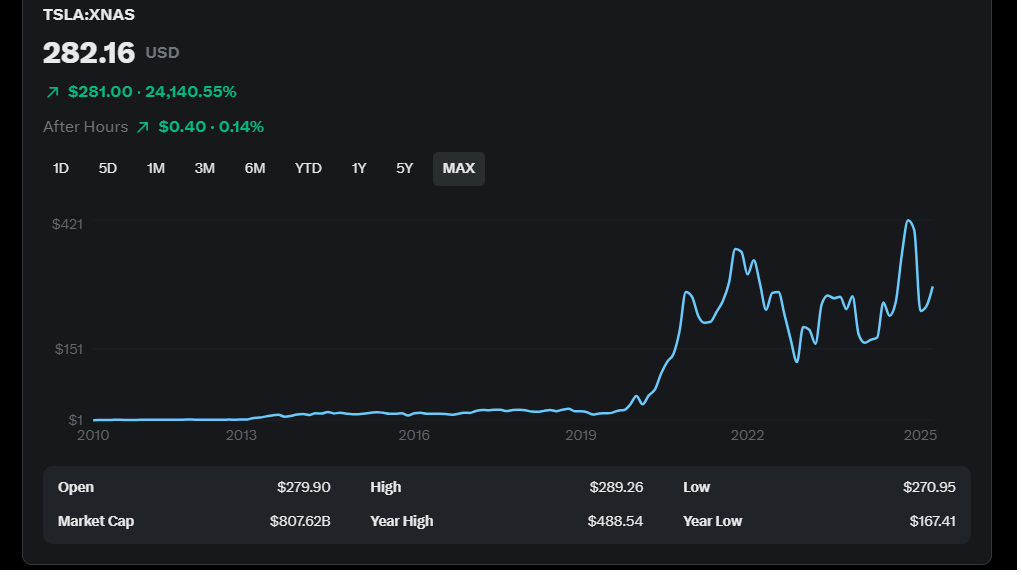| Stock Name | Tesla, Inc. |
| Stock Symbol | TSLA |
| IPO Year | 2010 |
| Stock Exchange | NASDAQ |
| Market Cap | $807.62 Billion (as per latest available data) |
| Founder | Martin Eberhard, Marc Tarpenning, Elon Musk, JB Straubel, Ian Wright |
| Incorporation | 2003 |
| Headquarter | Austin, Texas, United States |
| Sector | Consumer Discretionary |
| Industry | Automotive & Energy |
| Specialization | Electric Vehicles, Battery Energy Storage, Solar Energy Solutions |
Table of Contents
Company Overview (NASDAQ: TSLA)
Tesla, Inc. (NASDAQ: TSLA) is an American multinational enterprise that designs, manufactures, and sells electric vehicles, solar energy systems, and energy storage solutions. Founded in 2003 by Martin Eberhard, Marc Tarpenning, Ian Wright, JB Straubel, and Elon Musk, Tesla’s mission is to accelerate the world’s transition to sustainable energy.
Through models such as the Model S, Model 3, Model X, and Model Y, Tesla has disrupted the automotive market. Additionally, its Powerwall, Powerpack, and Solar Roof products have reshaped the renewable energy landscape.
This analysis presents forecasted share price ranges for 2025, 2030, 2040, and 2050. We also examine tomorrow’s price target, key earnings metrics, and the case for and against investing in Tesla.
Tesla, Inc. is headquartered in Austin, Texas. It specializes in:
- Electric Vehicles (EVs): Luxury and mass-market models with advanced battery technology and over-the-air software updates.
- Energy Products: Solar panels, Solar Roof tiles, and stationary energy storage (Powerwall & Powerpack).
Tesla’s vertically integrated business model—from cell manufacturing to vehicle assembly—enhances its cost efficiency and innovation pipeline.
Key Growth Factors of Tesla
- The revenue has grown at a CAGR of about 61.7% since 2010.
- Tesla’s stock price has grown at a CAGR of approximately 45.1% since its 2010 IPO.
Tesla Stock Price Forecast and Target for 2025
In 2025, Tesla’s stock price target is projected to be around $452.46, based on the average of major market forecasts.
This price reflects the strong growth trajectory Tesla is likely to continue, driven by its innovative position in the electric vehicle (EV) sector and its expanding footprint in renewable energy solutions. The electric vehicle sector, part of the broader automotive industry, is expected to experience significant growth, with increasing global demand for sustainable transportation options. Tesla, as a market leader, is well-positioned to benefit from advancements in battery technology and its autonomous driving systems.
However, this projection also takes into account broader geopolitical and economic factors. Geopolitical tensions, particularly trade relations between major economies, could have an impact on Tesla’s manufacturing and supply chain. On the economic front, while interest rates and inflation remain critical issues in many countries, Tesla’s ongoing innovation and leadership in both EVs and energy solutions could help mitigate some of these macroeconomic pressures. Additionally, the global push toward sustainability and the shift toward cleaner energy could continue to drive Tesla’s growth, despite any short-term volatility in the global economy or political landscape.
Forecast Range
Let’s assume a sensible forecast range around the average:
- Low (Yearly Minimum): $420
- High (Yearly Maximum): $485
| Year | Low | High |
|---|---|---|
| 2025 | $420 | $485 |
Tesla Stock Price Forecast and Target for 2030
Rationale
Key determinants by 2030 include successful deployment of Full Self-Driving (FSD) software, continued cost reduction in battery cells, and expansion of gigafactories worldwide.
Forecast Range
| Year | Low (\$) | High (\$) |
|---|---|---|
| 2030 | 800 | 1,032 |
Monthly breakdown anticipates incremental capacity additions and regulatory approvals:
| Month | Low (\$) | High (\$) |
|---|---|---|
| January | 800 | 878 |
| February | 820 | 850 |
| March | 832 | 871 |
| April | 844 | 879 |
| May | 853 | 890 |
| June | 867 | 911 |
| July | 885 | 923 |
| August | 898 | 936 |
| September | 905 | 957 |
| October | 947 | 978 |
| November | 964 | 990 |
| December | 988 | 1,032 |
Price Forecast for 2040
Rationale
By 2040, widespread EV adoption, advancements in solid-state batteries, and dominance in energy services could substantially elevate valuation multiples.
Forecast Range
| Year | Low (\$) | High (\$) |
|---|---|---|
| 2040 | 1,244 | 1,421 |
Projected monthly figures assume technological breakthroughs and market saturation dynamics:
| Month | Low (\$) | High (\$) |
|---|---|---|
| January | 1,244 | 1,287 |
| February | 1,261 | 1,296 |
| March | 1,276 | 1,307 |
| April | 1,288 | 1,321 |
| May | 1,269 | 1,308 |
| June | 1,280 | 1,321 |
| July | 1,298 | 1,355 |
| August | 1,288 | 1,350 |
| September | 1,294 | 1,367 |
| October | 1,311 | 1,387 |
| November | 1,350 | 1,401 |
| December | 1,390 | 1,422 |
Price Forecast for 2050
Rationale
Long-term drivers include Tesla’s potential leadership in autonomous mobility services, energy grid integration, and diversified revenue streams beyond automotive sales.
Forecast Range
| Year | Low (\$) | High (\$) |
|---|---|---|
| 2050 | 1,725 | 1,923 |
Anticipated monthly values reflect progressive market maturation and recurring service revenues:
| Month | Low (\$) | High (\$) |
|---|---|---|
| January | 1,725 | 1,768 |
| February | 1,736 | 1,777 |
| March | 1,751 | 1,790 |
| April | 1,767 | 1,812 |
| May | 1,789 | 1,834 |
| June | 1,775 | 1,821 |
| July | 1,790 | 1,853 |
| August | 1,811 | 1,871 |
| September | 1,843 | 1,890 |
| October | 1,832 | 1,876 |
| November | 1,852 | 1,890 |
| December | 1,870 | 1,923 |
Consolidated Forecast Summary
| Year | Low | High |
|---|---|---|
| 2025 | $186 | $503 |
| 2030 | $800 | $1,032 |
| 2040 | $1,244 | $1,421 |
| 2050 | $1,725 | $1,923 |
Divergent expert opinions underscore the inherent uncertainty in projecting equity valuations over extended horizons.
Investment Considerations
When evaluating TSLA, consider:
- Growth Catalysts: New vehicle launches, FSD progress, energy services expansion.
- Valuation Risks: High P/E multiples relative to traditional automakers.
- Competitive Landscape: Intensifying rivalry from legacy OEMs and emerging EV startups.
- Regulatory Factors: Government incentives and emission standards worldwide.
Latest Financial Metrics for Tesla
| Metric | Value |
|---|---|
| Market Capitalization | $807.62 billion |
| Price/Earnings (P/E) | 121.50 |
| Earnings Per Share (EPS) | $2.32 (TTM) |
| Diluted EPS | $2.13 (TTM) |
| Net Profit Margin | 5.8% |
| Revenue | $95.72 billion (TTM) |
| Net Income | $7.60 billion (TTM) |
| Operating Income | $8.84 billion (TTM) |
| Cash Flow from Ops | $13.29 billion (TTM) |
| Cost of Goods Sold | $78.13 billion (TTM) |
Tesla’s robust revenue growth reflects sustained consumer demand for EVs and energy products.
Investment Thesis: Bull vs. Bear Cases
Bull Case
- Rapid Scale: Global giga-factory network enables cost leadership.
- Software Upside: FSD subscription revenues could transform margins.
- Energy Integration: Vertically integrated energy products offer recurring revenue streams.
- Brand Equity: Strong consumer loyalty and market positioning.
Bear Case
- Valuation Pressure: Excessive multiples risk multiple contraction.
- Execution Risks: Production bottlenecks or FSD delays could erode confidence.
- Competition: Traditional automakers and tech entrants intensify market share battles.
- Macroeconomic Headwinds: Rising interest rates and supply chain disruptions.
Conclusion
Tesla’s pioneering technology and diversified business model position it for substantial long-term growth. However, lofty valuations and execution challenges inject volatility into its share price trajectory. Investors must align TSLA’s risk-reward profile with their strategic objectives.
Frequently Asked Questions
1. How has Tesla’s share price performed historically?
Over the past decade, TSLA shares have appreciated by over 10,000%, driven by product innovation and market optimism.
2. Beyond automobiles, what other segments does Tesla operate in?
Tesla’s portfolio includes solar energy systems and stationary energy storage solutions.
3. What are the primary risks to Tesla’s valuation?
Key risks include regulatory changes, competitive pressures, and execution shortfalls.
4. Is Tesla consistently profitable?
Yes. Tesla has delivered consecutive profitable quarters and expanding margins.
5. Can TSLA reach \$1,000 per share?
Many analysts believe a \$1,000 price point is attainable by 2029–2030, contingent on sustained growth.) please fact check this article and transform it into the corrected one and also notify about the mistakes it has . do not shorten the word count.
Disclaimer:
The views and opinions expressed in this article are solely those of the author and are intended for informational purposes only. They do not constitute financial, investment, or trading advice. Any stock price predictions mentioned are purely speculative and based on personal analysis. Past performance is not indicative of future results. Readers are advised to conduct their own research and, if necessary, consult a certified financial advisor before making any investment decisions. The author does not accept any liability for financial losses or gains arising from the use of this content.

